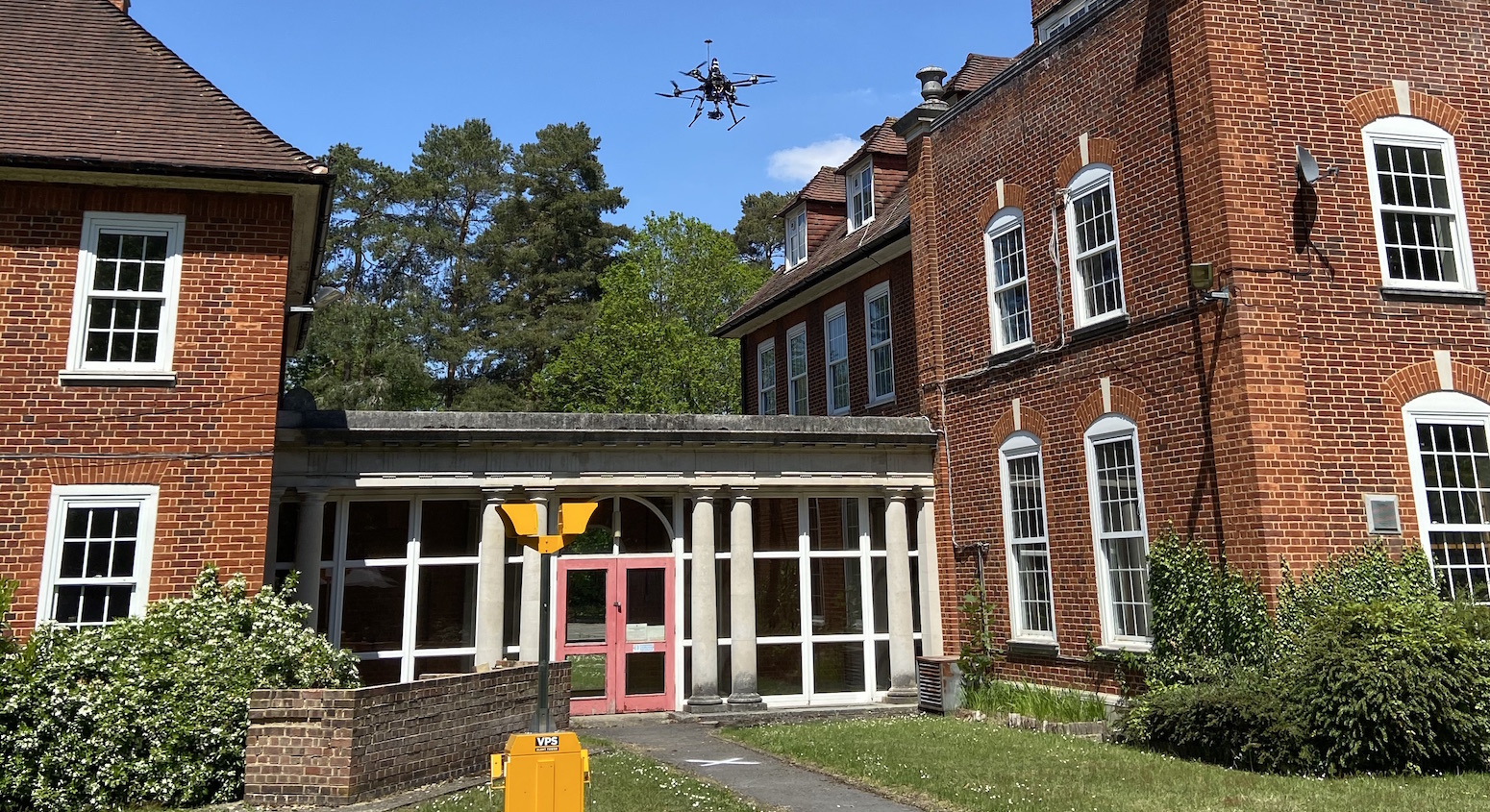
Surveying construction sites with a drone operated 50 miles away or more can bring a host of benefits, according to Skanska’s Peter Cater, who has been involved on the first construction trial. Denise Chevin finds out more.
Skanska was engaged in government-backed trials to road test the next generation of highly-autonomous drones for use in industrial environments, including construction sites. One of the test locations was on the site of the former Princess Royal barracks, in Surrey.
The site is being developed into a neighbourhood of Deepcut Village, with 1,200 homes and associated infrastructure, including roads, a school, sports pitches, allotments and green spaces and community places, plus the refurbishment of a listed church. Skanska is developing the site in partnership with the Ministry of Defence.
The redevelopment project was used to prove the value, safety and efficacy of a novel system that enables highly autonomous drones to be flown beyond visual line of sight (BVLOS) on industrial sites. Currently, BVLOS flights require permission from the Civil Aviation Authority and can only occur in specific, restricted cases. However, once the safety and efficacy of the system is proved, the intention is to deploy it at enterprise scale across UK infrastructure, energy networks and the emergency services.

“It was phenomenal to see this flying machine, manoeuvre skillfully around our building, undertaking tasks, knowing that the pilot was 50 miles away!”
The trial was led by drone technology firm sees.ai, with support from air traffic control services provider NATS and Vodafone. Funding for the project came from the Future Flight Challenge, Phase 2 competition, part of the Industrial Strategy Challenge Fund, delivered by UK Research and Innovation and funded by the Department for Business, Energy and Industrial Strategy (BEIS).
Peter Cater is Skanska’s development manager for the site, a role that involves selling parcels of land to housebuilders and developing the village infrastructure and instigating the trial.
Can you tell us more about the trials?
The idea of the trials, carried out last year, was to prove that a drone could be piloted from some distance away to carry out an inspection in a reasonably complex yet safe environment. The drone, piloted from 50 miles away, was used to carry out a high-level visual inspection of the newly completed, but unoccupied school. To do this, it was equipped with a gimbal and a high-resolution camera so that we could check details and finishes, part numbers, and generally snag to ensure if there were any noticeable defects, like bolts and fall protection being installed in the right place.
Normally, you wouldn’t need to be on site, but because this was a trial of the technology, we had standby pilots on the ground on the day and technicians. Also, the drone was driven to and launched from the site. In future, the idea would be either to have a drone permanently stationed on site to fly on demand by a remote pilot, or, eventually, for the drone to fly itself to site from a remote operation centre. At the moment, flying to the site is not allowed under CAA rules.
The drones are about 1.5m x 1.5m so fairly substantial, which allows a number of different technologies and sensors to be mounted on them. The part that sees.ai has developed is the ‘brain’ inside the drones, which allows them to ‘understand’ the space they are in.
The drones have multiple, specialised LiDAR sensors that scan the environment in real-time and build a 3D model of the live environment. This 3D model is updated constantly and transmitted to the pilot, anywhere in the world over the mobile network. The pilot then flies the drone in that model, also using a visual camera to check (a little like playing in a game). [In the video below] the pilot has three screens, showing the model whole, live camera feed, and live 3D model flying view.
These days drones are increasingly being used for inspections with the pilots on site – why do we need remote drones?
The traditional method would be that you have people working at height, or people getting platforms and scaffold and going up and inspecting, which is very intense from a safety, carbon and cost perspective. That’s if it gets done at all.
When you have drones piloted on site, that still requires a couple of people driving to the site, which can take a few hours, so it’s still quite time-, risk- and carbon-intensive. Compare that to a pilot turning on a few screens and carrying out the mission instantly and then charging for the time it takes to do the flight.
If you can push down costs, it can become an affordable, safe, low-carbon and quick solution for making sure what is built is of a high quality.
Taking flight – the CAA’s position
The CAA Regulatory Sandbox was created in April 2019 to facilitate innovation and exploration in aviation in line with CAA core principles of safety, security and consumer protection. sees.ai was the seventh entity to join the Sandbox and sits alongside companies like Amazon, Boeing and Volocopter.
According to the CAA, BVLOS operations in the UK could bring huge benefits, including: drone parcel delivery from a distribution centre to a customer; long-distance aerial surveys of infrastructure, such as power lines or highway construction; surveillance at the scene of an accident or incident, operated from an external control centre; and street mapping a whole city using optical and acoustic sensors.
How did the trial come about?
I met John McKenna, CEO of sees.ai, at a roundtable event with a number of start-ups and I could see straight away the benefits the technology could deliver to the industry.
McKenna has previously said: “It’s already possible to build fully autonomous systems, but they are quite limited in terms of what they can do. Teaming up a human pilot with a highly-automated machine makes it possible to do far more and far more cost effectively. It mirrors what is happening in the autonomous vehicle world, where fully-autonomous cars are driving around our streets but with a human driver who takes over control whenever there’s an exception.”
Do you see the results in real-time?
So, we were looking at a live feed, but it also captures video, which I think is also equally important. You know, sometimes you don’t have the experts there at the time.
Did you learn anything interesting from the trial?
It was phenomenal to see this flying machine, manoeuvre skillfully around our building, undertaking tasks, knowing that the pilot was 50 miles away!
During the trial we performed a high-level inspection of the roof, skylights and upper floor external finishes, which confirmed all was built to design and defect-free.
There wasn’t really anything that did not work as well as expected and that’s mainly because, having been involved at that point with sees.ai for a couple of years already, I was very aware of what the limitations of this first trial stage were. I look forward to seeing the future generations of these drones, flying around busy construction sites, but for the test, it had to be an empty building and site.
When will the technology start making an impact in construction?
If I knew that I’d probably be quite wealthy. It all depends how quality tests can be performed with the industry, and how soon we can move as a country to allow these things to happen. The technology is there, they can do the surveys and they can be operated by a remote pilot.
The sees.ai system must be able to terminate the mission safely should communications fail; if that happens, the drone will switch to fully autonomous mode and safely retrace its path and terminate the mission.
But there needs to be a legislative change and a thorough risk-based approach to drone testing that says: “Actually this is safe.” Having said that I, understand that BEIS is specifically looking at ways that they can ease the legislative burden for drone piloting. Because they do see this as a real key area of growth. And something that the UK can be best-in-class at.
Once you have the ability to do these high-level inspections at low cost and that includes using LiDAR and photogrammetry, as well as video, then the technology becomes ubiquitous, and it becomes ingrained.
It’s very easy to be dismissive about emerging technology in the construction industry if it can’t help today. But if we all adopted that attitude, then technology that will benefit us tomorrow doesn’t get all the support it needs to get to market. So early engagement is paramount – it’s an important part of a digital culture. That’s what enables these kinds of great technical, technological leaps in our industry.
Don’t miss out on BIM and digital construction news: sign up to receive the BIMplus newsletter.












